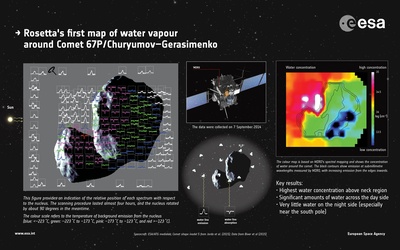MIRO maps water in comet’s coma
MIRO, the Microwave Instrument for the Rosetta Orbiter, first detected the emission from water molecules in the coma of Comet 67P/C-G on 6 June 2014, when Rosetta was 350,000 km from the comet, approximately equivalent to the distance of the Earth from the Moon. At the time, the comet was 3.9 AU – about 580 million km – from the Sun.
Since early July 2014, the MIRO team have been continuously monitoring water in the comet's environment, measuring its properties at different locations across the coma. Being in very close proximity to 67P/C-G, Rosetta, with the MIRO instrument on board, can 'dissect' the distribution of water and other molecules around the comet. Existing ground-based observatories and near-Earth space telescopes can at most get a global view of water in the outermost parts of a comet's coma.
As Rosetta approached the comet and MIRO could resolve the nucleus, the instrument was able to detect water in the coma by measuring the direct emission from water vapour in the coma and by observing absorption of radiation from the nucleus at water specific frequencies as the radiation passed through the coma.
On 7 September 2014, when Rosetta was 58 km from the comet centre, the MIRO team obtained their first map of the nucleus of 67P/C-G and its surroundings. Since MIRO is a single-pixel instrument, the scanning procedure took almost four hours, during which the nucleus had turned by about 90 degrees.
The map shows 201 spectra, covering the nucleus as well as parts of the coma around it. Each spectrum corresponds to the average of one to four nearby spectra, that were combined to obtain a higher signal-to-noise ratio.
The strongest signatures of water emission are observed in the off-nucleus spectra on the comet's day side; similarly, the strongest absorption features are seen in the spectra covering the day side of the nucleus. A few spectra sampling both coma and nucleus on the limb exhibit a combination of emission and absorption features.
Weak absorption was observed in the spectra covering the cool nucleus on the comet's night side, while only weak emission was detected over some of the coldest spots on the nucleus, with hardly any signs of water close to the south pole of 67P/C-G. The off-nucleus spectra on the night side also show weak emission lines from water in the coma.
This map was obtained using the spectral line of the H216O water molecule at a frequency of 556.936 GHz. An analogous, but coarser map was obtained using a much fainter spectral feature detected at a frequency of 547.676 GHz, characteristic of a different type of water molecule, H218O, which contains a heavy oxygen (18O) atom.
“Our observations show that the distribution of water in the coma is highly inhomogeneous,” explains Nicolas Biver, CNRS researcher at LESIA-Observatoire de Paris in Meudon, France, and lead author of the study.
“We found the highest density of water just above the neck, close to the north pole of the comet's rotation axis: in this narrow region, the column density of water is up to two orders of magnitude higher than elsewhere in the coma,” adds Dr Biver.
Lower but still substantial amounts of water are detected over the day side of the nucleus up to the terminator between the illuminated and dark side. The lowest amounts of water are found on the comet's night side – particularly over the southern polar regions; these could be due to either local outgassing or circulation effects within the coma, causing water to flow from the day to the night side.
Since last September, scientists in the MIRO team have obtained and are still analysing more maps of the distribution of water in the coma of 67P/C-G, as the comet is moving closer to the Sun.
Dr Sam Gulkis, Principal Investigator of MIRO, reports that the instrument is performing well, and observations of 67P/C-G are continuing daily as the comet approaches perihelion in August 2015.
MIRO: The MIRO instrument was built at the Jet Propulsion Laboratory, California Institute of Technology with contributions from LESIA and LERMA, Observatoire de Paris and the Max-Planck-Institut für Sonnensystemforschung. Funding was provided by the National Aeronautics and Space Administration, CNES and CNRS/INSU, and DLR and MPG.
